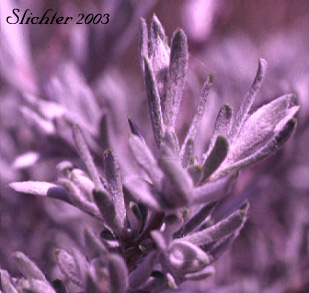Silver sagebrush as seen along Rhyolite Ridge about one-half mile west of Pilot Rock, Cascade-Siskiyou National Monument.....May 26, 2021.
Silver sagebrush as seen along Rhyolite Ridge about one-half mile west of Pilot Rock, Cascade-Siskiyou National Monument.....May 26, 2021.
 Silver sage as seen
at the radio tower atop Gordon Ridge, directly southeast from the mouth of the
Deschutes River, Columbia River Gorge........April 23, 2000.
Silver sage as seen
at the radio tower atop Gordon Ridge, directly southeast from the mouth of the
Deschutes River, Columbia River Gorge........April 23, 2000.
Also known as hoary sagebrush, silver sage is branched, rounded shrub from 50-120 cm high. The plants spread underground and can rapidly grow back after fire. The leaves are broadly linear to linear-oblong in shape and are covered with a dense, silvery covering of short hairs (as seen in the photos). The leaves range from 3-6 cm long and 1.5 -5 mm long. They usually have entire margins, although some may have one or two lateral lobes.
The inflorescence consists of numerous leafy panicles. The panicles range from 10-30 cm long. The involucres are 4-5 mm high. All the bracts are often tomentose, or the leafy outermost bracts may be tomentose while the ovate to orbicular-shaped mid and inner bracts may be glabrous. The flower heads consist of 8-15 discoid flowers.
Silver sage may be found in dry to moderately moist meadows and bottomlands, often soils with poorer drainage.
Silver sage may be found to the east of the Cascade Mts. from central Oregon south into California (to the east of the Sierra Nevada) and east through central Idaho to southern Saskatchewan, Nebraska, Colorado, and northern Arizona.
Silver sagebrush as seen along Forest Service Road #1647 in southeastern Logan Valley, Malheur National Forest...........August 3, 2011.